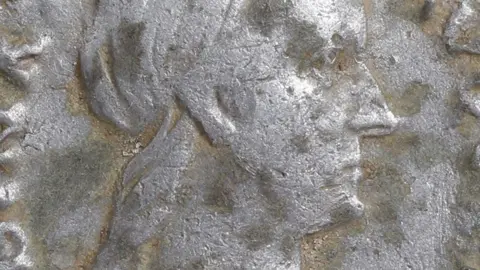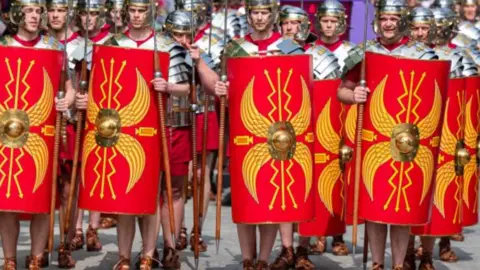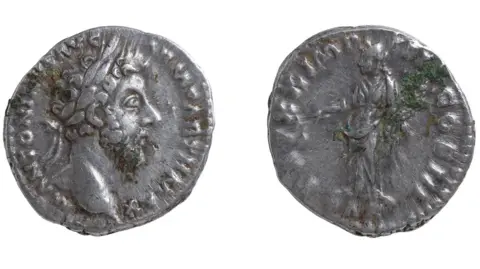Coins worth Roman soldier's monthly wage found
 Andrew Williams/Norfolk County Council
Andrew Williams/Norfolk County CouncilA Roman silver coin hoard worth almost the same as a legionary's monthly wage in the 2nd Century has been uncovered by a metal detectorist.
The discovery of 25 coins was made in a field near Great Ellingham, north of Attleborough, Norfolk, with the latest denarius unearthed in 2023.
Coin expert Adrian Marsden said the purse loss was probably disturbed by a plough "and had been sloshing around in a field ever since".
It is one of two denarius hoards currently going through the treasure process in Norfolk.
 Getty Images
Getty ImagesDr Marsden, from the Norfolk Historic Environment Service, said: "A silver denarius is reasonably valuable and about one day's pay for a legionary, so with the Great Ellingham hoard we're looking at nearly a month's wages - they were well paid."
Legionaries were the Roman Empire's citizen soldiers, men who had to meet strict physical and social requirements for recruitment.
This meant they had to be at least 1.72m (5ft7in) tall, needed a letter of recommendation, faced gruelling training and had to take an oath to serve in the army for at least 25 years.
On retirement, they received a pension worth a decade's pay.
 Andrew Williams/Norfolk County Council
Andrew Williams/Norfolk County CouncilThe second hoard of 13 denarii was found near Walpole Highway, a village north of Wisbech, Cambridgeshire.
Coins in both hoards range from the AD60s to AD180s, including for emperors such as Trajan, his cousin Hadrian and Marcus Aurelius.
They also include coins minted for imperial wives such as Faustina I, her daughter Faustina II - and Sabina.
"What's nice about these little silver denarii is the people in them are instantly recognisable, with hooked noses or beards," said Dr Marsden.
"If you walk around a Roman sculpture collection, you can pick them out one by one - and they are not idealised like later Christian emperors, these are real people getting the warts and all treatment on the coinage."
In the vast 2nd Century empire, stretching from the Tigris-Euphrates river system in Turkey to the borders of Scotland, "it's certain everyone knows what the emperor looks like as a result of coins," the numismatist added.
If declared treasure, museums will get first refusal over whether to acquire the hoards.
Follow Norfolk news on BBC Sounds, Facebook, Instagram and X.
